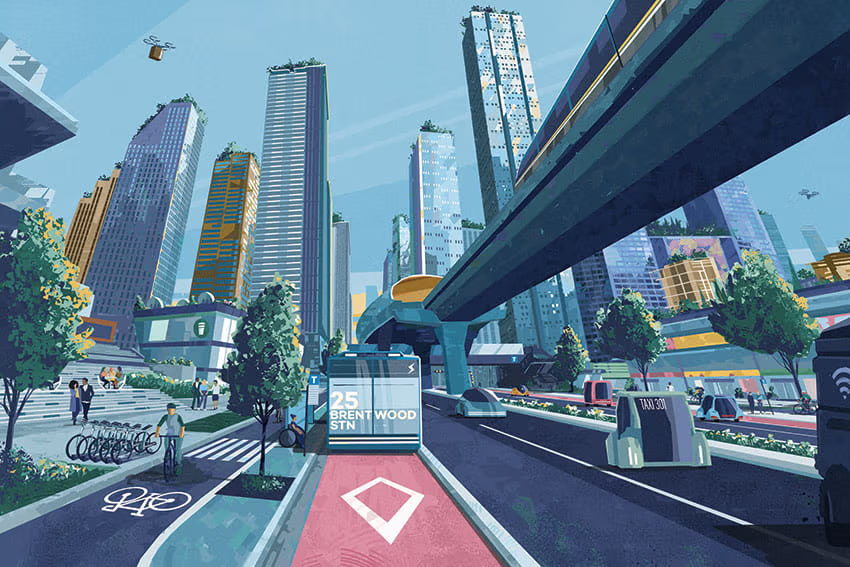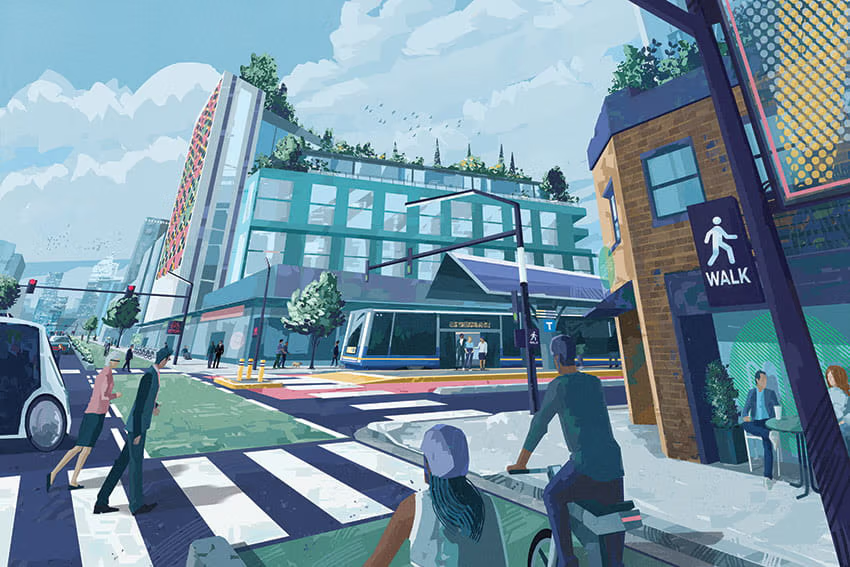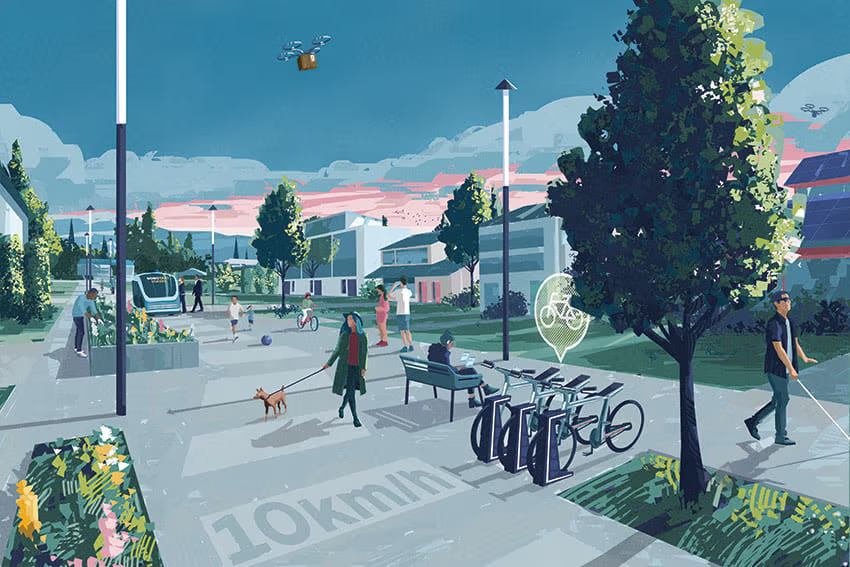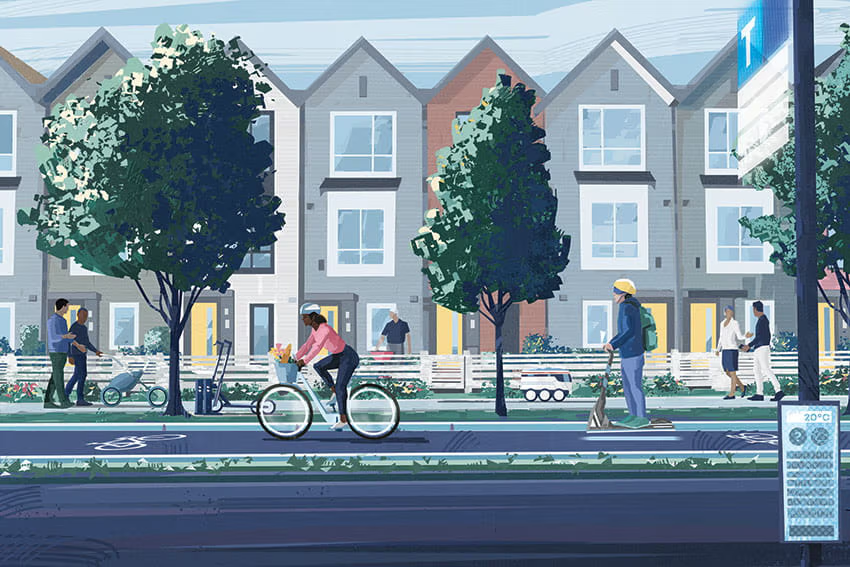Read Transport 2050: 10-Year Priorities and the Executive Summary. The 10-Year Priorities Maps is a compilation of maps detailing the transportation investments outlined in the 10-Year Priorities.

The new Regional Transportation Strategy will improve transportation for the people who live, work, and play in Metro Vancouver.
Designed to be flexible in an era of rapid change, Transport 2050 is our roadmap for the next 30 years. It identifies projects, services, and policies to make transportation better for everyone.
Transport 2050
The current Regional Transportation Strategy is Transport 2050. Created as part of TransLink’s largest-ever public engagement, Transport 2050 was adopted on January 27, 2022.
In Transport 2050, we’ve identified five goals for regional transportation: convenient, reliable, affordable, safe & comfortable, and carbon-free. The strategy also identifies over 100 actions to improve transportation across all modes. Some of the transformative actions include:
-
Quadrupling the size of the rapid transit network, from 100 to 400 kilometres
-
Building out an 850-kilometre traffic-protected Major Bikeway Network
-
Putting frequent transit within a short walk of most homes and jobs
-
Dedicating more streets to walking, biking, rolling, and transit
-
Promoting electrified and shared bikes, scooters, and cars
The new Regional Transportation Strategy responds to residents’ top priorities, such as climate change and affordability, and will create more transportation options for everyone.
Read Transport 2050
For a more screen-reader friendly version of the Transport 2050 Regional Transportation Strategy, please refer to the list of individual parts in PDF format.
Interactive Version
Individual Parts
-
Part A: Transport 2050 Scope and Linkages to Other Plans (Page 32-43, 1.7 MB)
-
Part B: Regional Context, Challenges, and Opportunities (Page 44-71, 11.7 MB)
-
Part E: Strategies & Actions - Introduction (Page 84-87, 655 KB)
-
Part E: Goal One - Convenient Choices for Everyone (Page 88-123, 14 MB)
-
Part E: Goal Two - Reliable Choices for Everyone (Page 124-145, 4.8 MB)
-
Part E: Goal Three - Affordable Choices for Everyone (Page 146-159, 984 KB)
-
Part E: Goal Four - Safe and Comfortable Choices for Everyone (Page 160-185, 3.6 MB)
-
Part E: Goal Five - Carbon-Free Choices for Everyone (Page 186-199, 774 KB)
-
-
Part H: Performance Monitoring and Evaluation Framework (Page 228-241, 700 KB)
Regional Transportation Strategy
The Regional Transportation Strategy (RTS) is a long-term strategy that shapes the future of transportation in Metro Vancouver. TransLink is legislatively required to update the RTS every five years, which helps ensure that our transportation system evolves with the region.
The RTS must set out the goals, directions, and key initiatives for the entire regional transportation system, across all modes. It must consider regional land use objectives, provincial transportation and economic objectives, and provincial and regional environmental and emissions reduction objectives.
Transport 2050: 10-Year Priorities
Transport 2050: 10-Year Priorities sets out what we — as a region— think we should get started on right away. It builds on the 2014 Mayors’ Vision, incorporating remaining investments yet to be implemented, and identifies our top priorities for the first decade of Transport 2050, which will be funded through future Investment Plans starting in 2024 or 2025.
Using the goals and strategies in Transport 2050, and engaging the public, Indigenous Peoples, stakeholders, and partners, the following is a summary of the priorities for the first 10 years:
-
More than doubling bus service levels across the region
-
Developing approximately 170 kilometres of new rapid transit on up to 11 corridors, including:
-
Up to nine Bus Rapid Transit (BRT) routes using new zero-emission buses on dedicated, traffic-separated lanes
-
A rapid transit connection to the North Shore
-
The Burnaby Mountain Gondola to SFU
-
The Millennium Line SkyTrain extension from Arbutus to UBC
-
Exploring other potential SkyTrain extensions, including Newton in Surrey and Port Coquitlam
-
Investing in 450 kilometres of new traffic-separated cycling paths
-
Investing in improving customer experience and amenities
-
Innovating in automated, electric, and shared mobility
-
Building the foundation for the digitalization of mobility
-
Improving our relationships with Indigenous Nations and urban Indigenous Peoples and making progress on reconciliation
-
Making our infrastructure more resilient to seismic risks and climate change
-
Understanding the social equity impacts of our investments on disadvantaged communities and ensuring we have the data and consultation to maximize our investments for our customers
100+ Actions
Transport 2050 identifies over 100 actions to deliver transportation choice. Whether you walk, bike, roll, transit, or drive. These actions will also help the region reach its goals.

Putting rapid transit within a short walk of most people and frequent local transit within a short walk of nearly everyone

Creating an 850-kilometre major bikeway network

Dedicating more streets to walking, biking, rolling, and transit

Promoting electric and shared vehicles: bikes, scooters, and cars
A Shared Strategy for the Region
Transport 2050 was created from TransLink’s largest-ever public engagement. Thanks to your input — and from partnerships across the region — we have a strategy to shape the future of how we move and live.
360
events (in-person or virtual)
38,000+
surveys completed
500+
stakeholder groups engaged
160k+
discussions
4k
ideas submitted
184
days of engagement
Previous Regional Transportation Strategies
RTS Strategic Framework (2013)
Transport 2040 (2008)
Transport 2021 (1993)
Project Updates
Interested in Transport 2050 and other projects? Sign up for the TransLink E-Newsletter to get updates directly to your inbox.

